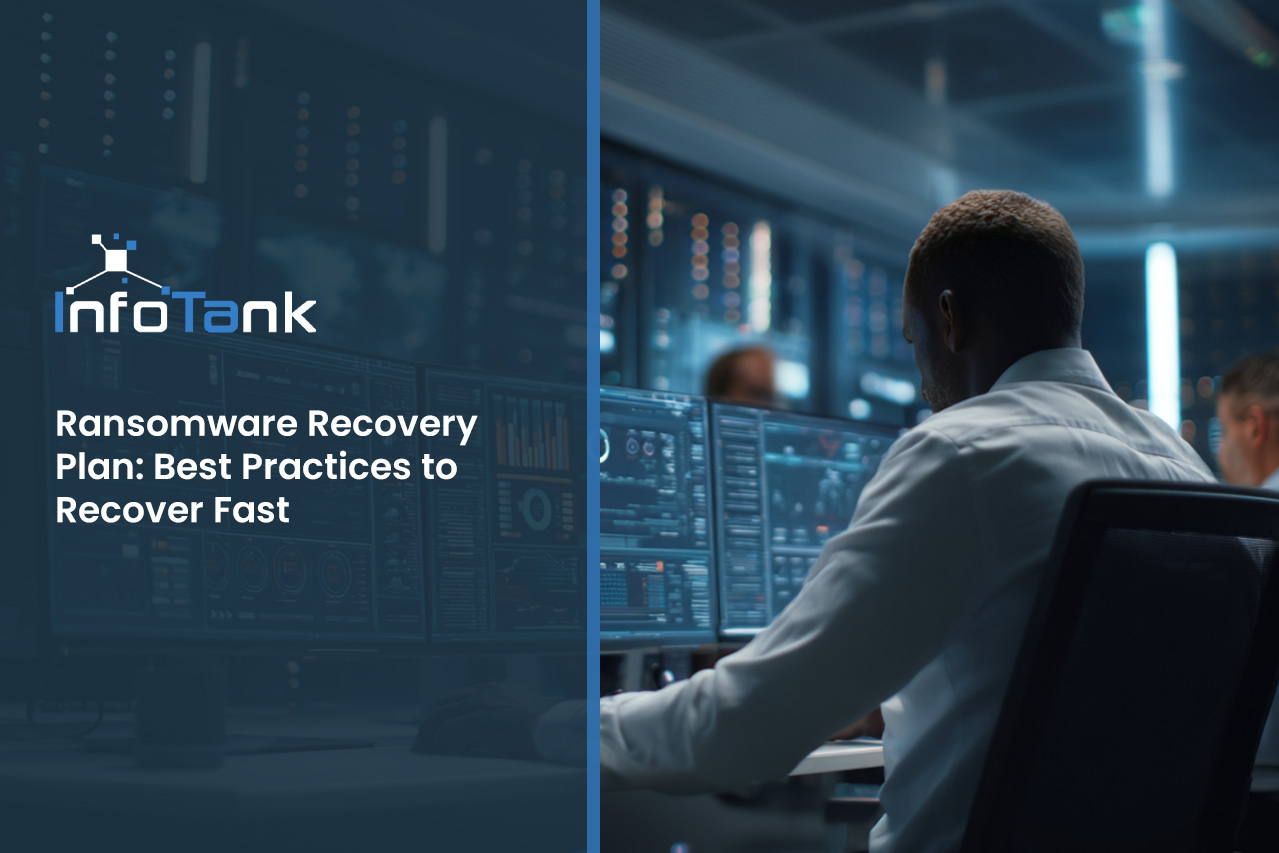
Ransomware Recovery Plan: Best Practices to Recover Fast
A ransomware recovery plan is no longer optional—it's essential. Cybercriminals are targeting businesses of all sizes, encrypting critical files, and demanding ransom payments. In this blog, you'll learn how to build a reliable recovery plan, avoid common mistakes, and protect your business from future ransomware attacks. We’ll also cover ransomware recovery planning, backup strategies, and how to restore data quickly after an incident.
[.c-button-wrap2][.c-button-main2][.c-button-icon-content2]Contact Us[.c-button-icon-content2][.c-button-main2][.c-button-wrap2]
What is a ransomware recovery plan and why it matters
A ransomware recovery plan is a documented process that outlines how your business will respond to and recover from a ransomware attack. It includes steps for identifying the attack, isolating affected systems, restoring data, and resuming operations. Without a plan, recovery becomes chaotic, slow, and costly.
Many businesses underestimate how much damage ransomware can cause. Beyond the ransom demand, you risk data loss, downtime, and reputational harm. A strong recovery plan helps you act fast, reduce disruption, and avoid paying the ransom altogether.

Key strategies for building an effective ransomware recovery plan
Every recovery plan should be tailored to your business, but there are common strategies that make any plan stronger. Here are the most important ones to include:
Strategy #1: Identify critical systems and data
Start by listing the systems and data your business can’t function without. This helps you prioritize what to protect and recover first. Include customer databases, financial records, and operational tools.
Strategy #2: Use immutable backups
Immutable backups can’t be changed or deleted—even by ransomware. Store them offsite or in the cloud with version control. This ensures you always have a clean copy to restore.
Strategy #3: Test your recovery process regularly
A plan is only useful if it works. Schedule regular recovery drills to test how fast you can restore systems. This helps you find gaps and improve your recovery time.
Strategy #4: Include an incident response plan
Your recovery plan should work hand-in-hand with your incident response plan. This outlines who does what during an attack, from IT teams to legal and communications.
Strategy #5: Document recovery procedures step-by-step
Write down exactly how to recover each system. Include login credentials, backup locations, and vendor contacts. This saves time and avoids confusion during a crisis.
Strategy #6: Monitor for ransomware threats
Use cybersecurity tools to detect ransomware early. The sooner you know there’s a problem, the faster you can isolate it and start recovery.
Strategy #7: Train your team
Employees are often the first line of defense. Teach them how to spot phishing emails and report suspicious activity. Human error is a common entry point for ransomware.
Essential elements of a strong recovery plan
A complete ransomware recovery plan should include:
- A list of critical data and systems to prioritize during recovery
- Defined roles and responsibilities for your response team
- Clear steps for isolating infected systems
- Access to secure, off-site backups
- Communication plans for internal and external stakeholders
- A timeline for restoring operations

IT professional planning ransomware recovery
How backup systems support ransomware recovery
Backup systems are the foundation of any ransomware recovery plan. Without them, you may have no choice but to pay the ransom. But not all backups are created equal.
Use a mix of local and cloud-based backups. Make sure they run automatically and are tested regularly. Store at least one copy offline to protect against ransomware that targets connected drives. And always encrypt your backup data to keep it secure.
Key benefits of having a ransomware recovery plan
Having a plan in place gives your business several advantages:
- Faster recovery after a ransomware attack
- Reduced downtime and financial loss
- Clear roles and responsibilities during a crisis
- Better compliance with data protection regulations
- Increased confidence from customers and partners
- Lower risk of needing to pay the ransom

Recovery strategies for different types of ransomware
Not all ransomware works the same way. Your recovery strategy should match the type of ransomware you’re dealing with. Here’s how to approach different scenarios:
Strategy #1: File-encrypting ransomware
This type locks your files and demands payment for a decryption key. If you have clean backups, you can wipe the system and restore data without paying.
Strategy #2: Locker ransomware
Locker ransomware blocks access to your system but doesn’t encrypt files. In this case, recovery may involve rebooting in safe mode or using specialized tools to remove the malware.
Strategy #3: Double extortion attacks
Here, attackers steal your data before encrypting it. Even if you recover from backups, they may threaten to leak your data. Include legal and PR steps in your plan to handle this.
Strategy #4: Ransomware-as-a-Service (RaaS)
These attacks are carried out by affiliates using rented ransomware tools. They often follow known patterns, so threat intelligence can help you respond faster.
Strategy #5: Targeted ransomware attacks
Some attacks are customized for your business. These require a more tailored response, including forensic analysis and possibly working with law enforcement.
Strategy #6: Wiper malware disguised as ransomware
Some malware pretends to be ransomware but actually deletes your data. In this case, recovery depends entirely on having offsite, immutable backups.
Strategy #7: Attacks on backup systems
Some ransomware targets your backups first. Use layered security and access controls to protect backup storage from being encrypted or deleted.
How to implement your ransomware recovery plan
Once your plan is written, it’s time to put it into action. Start by assigning roles and training your team. Make sure everyone knows what to do and who to contact during an incident.
Next, integrate your recovery plan with your broader disaster recovery and cybersecurity strategies. Run tabletop exercises and real-world simulations to test your plan. Update it regularly based on new threats and lessons learned.
Best practices for ransomware recovery planning
To make your planning process more effective, follow these best practices:
- Involve both IT and business leaders in planning
- Keep your plan simple and actionable
- Use automation to speed up detection and response
- Store your plan in a secure but accessible location
- Review and update the plan every quarter
A strong plan doesn’t just help you recover—it helps you prevent future attacks.

How InfoTank can help with a ransomware recovery plan
Are you a growing business looking to protect your operations from ransomware? If you’re managing sensitive data or rely on digital systems to run your business, you need a ransomware recovery plan that works when it counts.
At InfoTank, we help businesses build, test, and maintain effective ransomware recovery plans. Our team can guide you through every step—from assessing your risks to setting up secure backups and running recovery drills. Don’t wait until after an attack. Contact us today to get started.
[.c-button-wrap2][.c-button-main2][.c-button-icon-content2]Contact Us[.c-button-icon-content2][.c-button-main2][.c-button-wrap2]
Frequently asked questions
What should I do immediately after a ransomware attack?
First, disconnect affected systems from the network to stop the spread. Then, begin your ransomware recovery process by identifying the type of ransomware involved. Notify your IT team and follow your incident response plan. Avoid paying the ransom unless all recovery options fail.
Next, assess the damage and start restoring from backups if available. Use malware removal tools to clean infected systems before restoring. Document everything for legal and insurance purposes.
How can I prevent ransomware from infecting my business?
To prevent ransomware, keep all software up to date and apply security patches quickly. Train employees to recognize phishing emails and suspicious links. Use strong antivirus and endpoint protection tools.
Also, segment your network to limit access and use multi-factor authentication. Regularly back up data and store copies offline or in immutable backups. Prevention is your first line of defense.
Should I pay the ransom if my data is encrypted?
Paying the ransom is risky. There's no guarantee you'll get your data back, and it encourages more attacks. Instead, rely on your backup and recovery plan to restore systems.
If you don’t have clean backups, consult cybersecurity experts. They may help you recover encrypted data or find decryption tools. Always report the incident to law enforcement.
How long does ransomware recovery usually take?
Recovery time depends on the size of the attack and your preparedness. With a solid recovery plan and recent backups, you can recover quickly—often within hours or days.
Without a plan, recovery could take weeks and cost thousands in downtime. Testing your plan regularly helps reduce recovery time and ensures your team knows what to do.
What kind of data should I back up to prepare for ransomware?
Back up all critical data, including customer records, financial files, and operational documents. Don’t forget configuration files and system images.
Use a 3-2-1 backup strategy: three copies of your data, on two different media, with one stored offsite. Encrypt your backups and test them regularly to ensure they work.
Can ransomware affect cloud-based systems?
Yes, ransomware can infect cloud systems, especially if they’re synced with infected local devices. That’s why it’s important to use cloud services with strong security controls.
Enable versioning and immutable backups in your cloud storage. Monitor for unusual activity and restrict access using role-based permissions. Cloud doesn’t mean invincible—stay vigilant.



